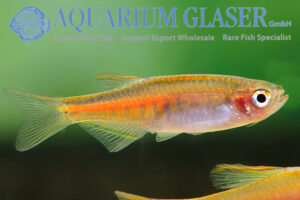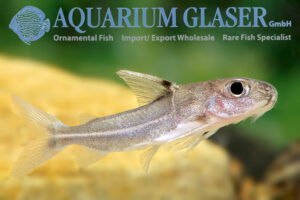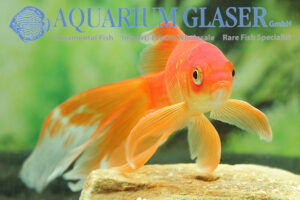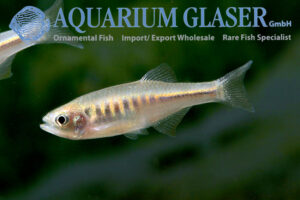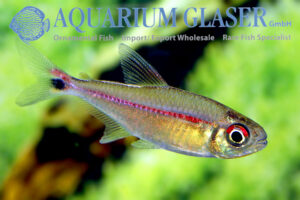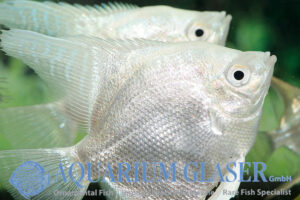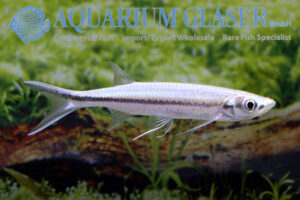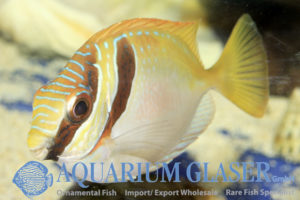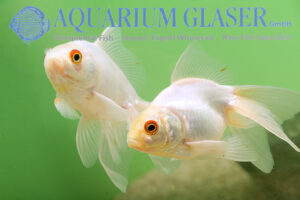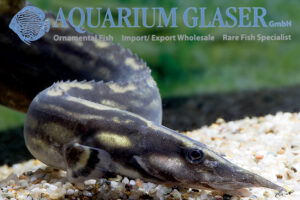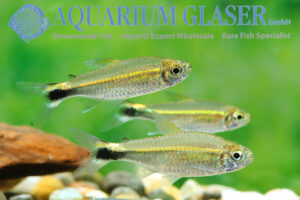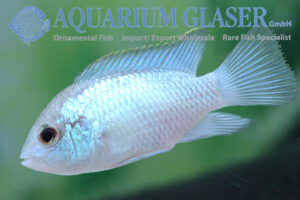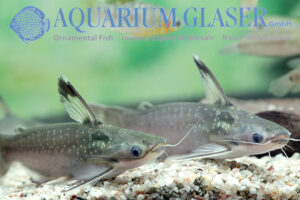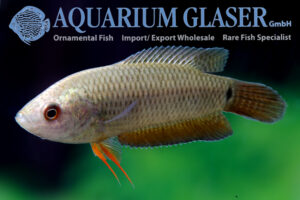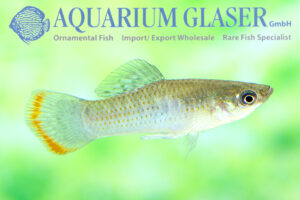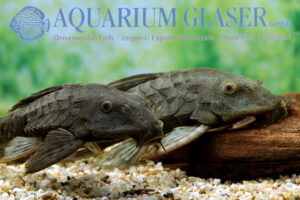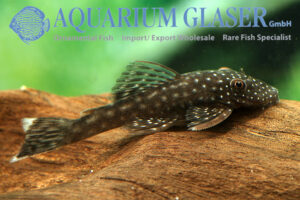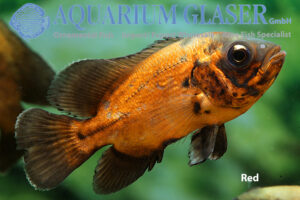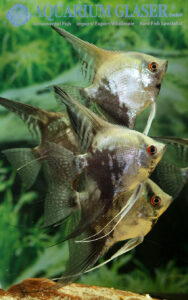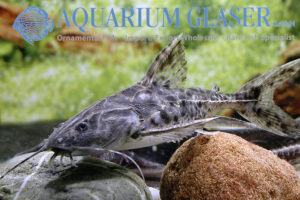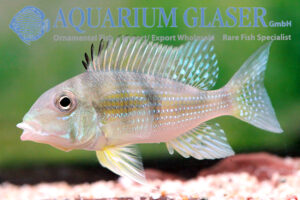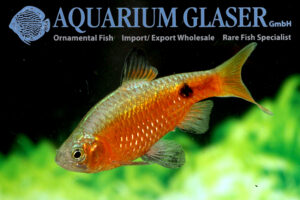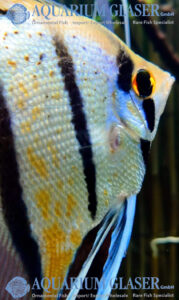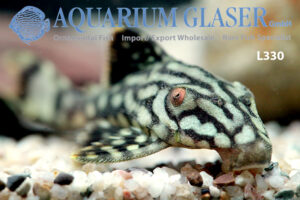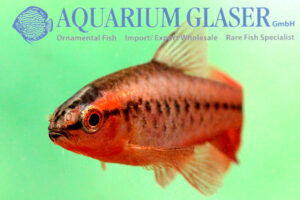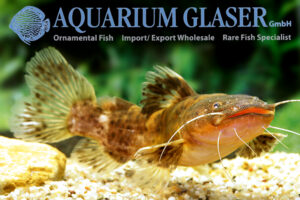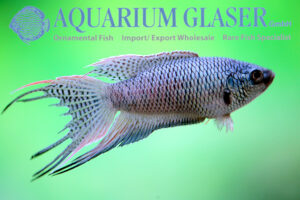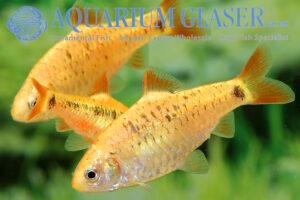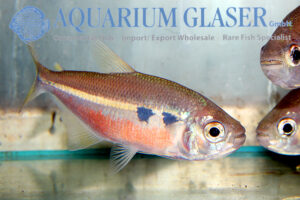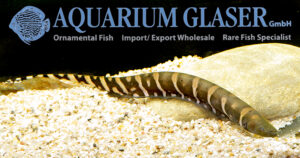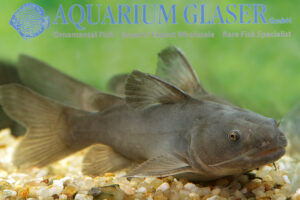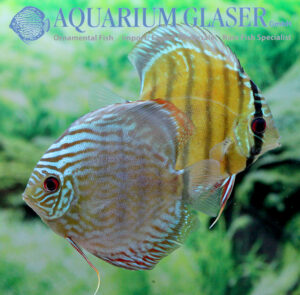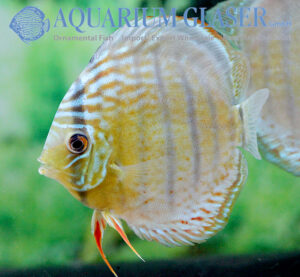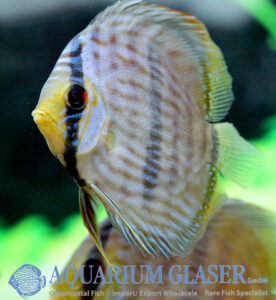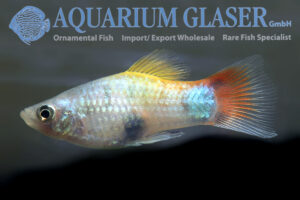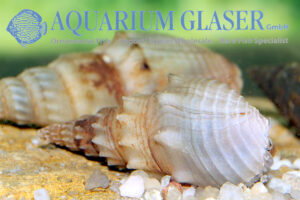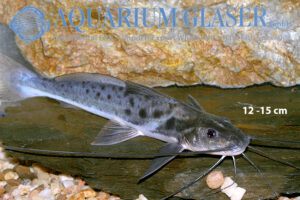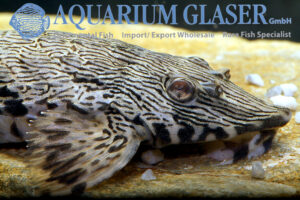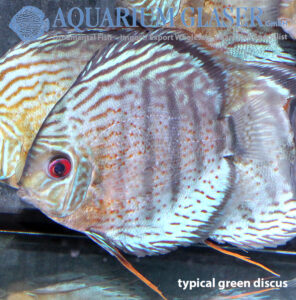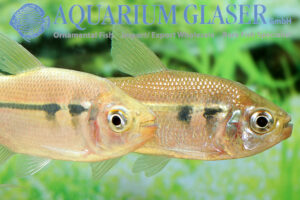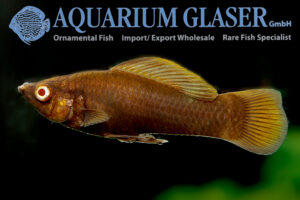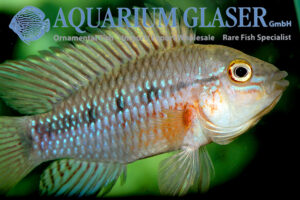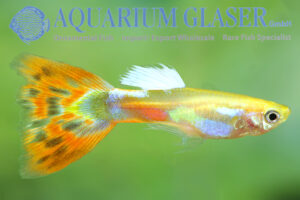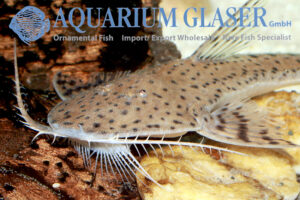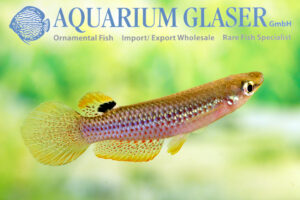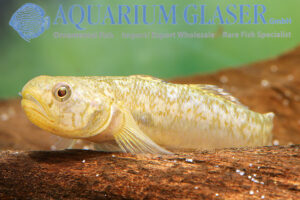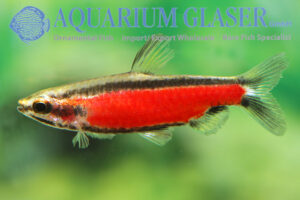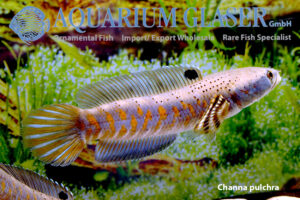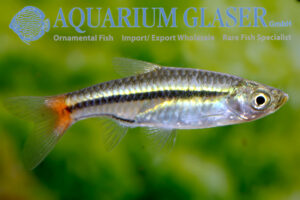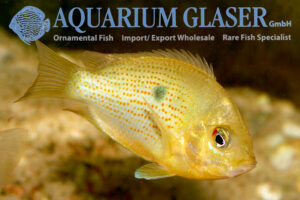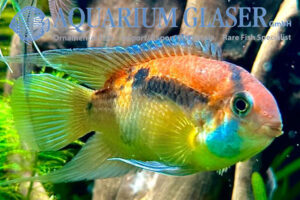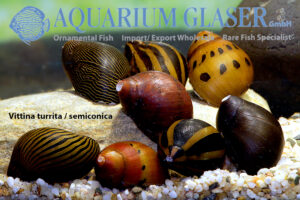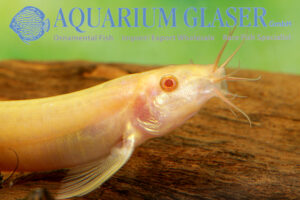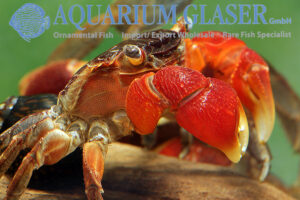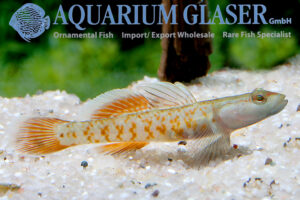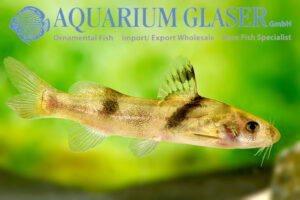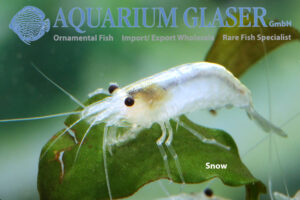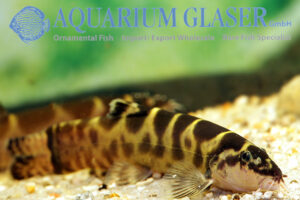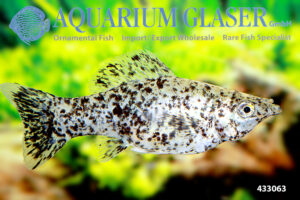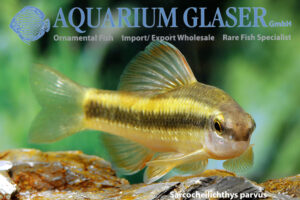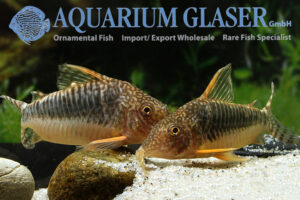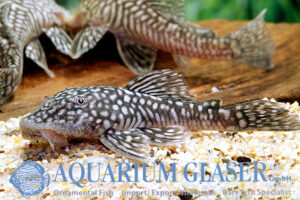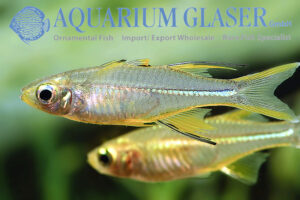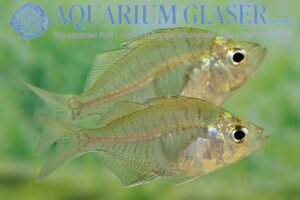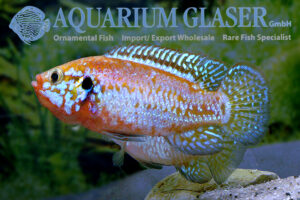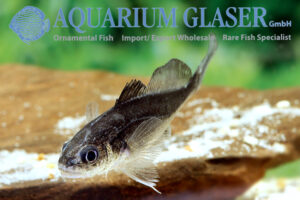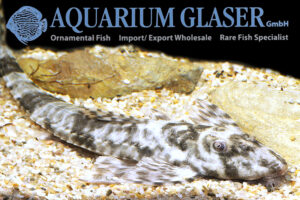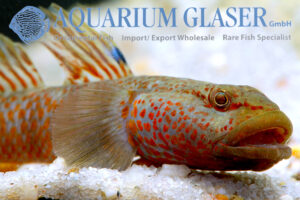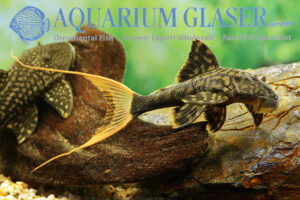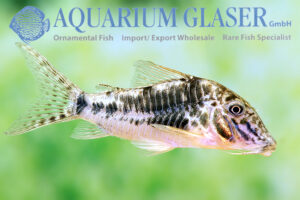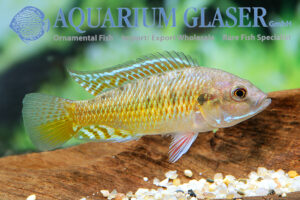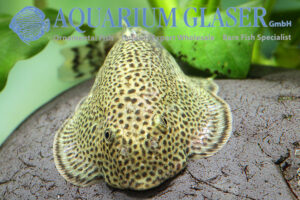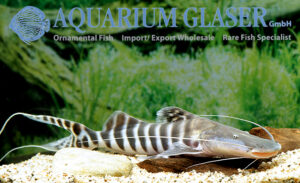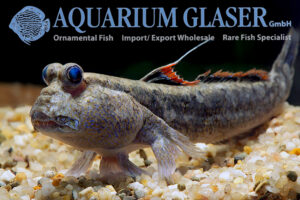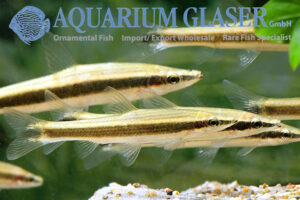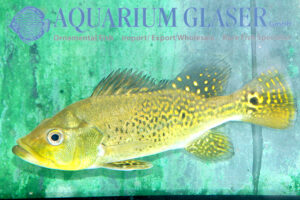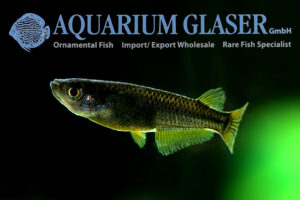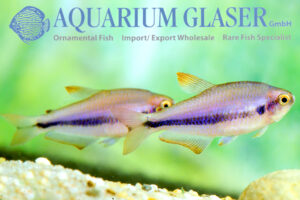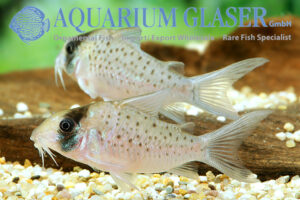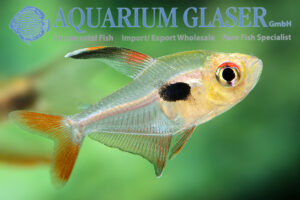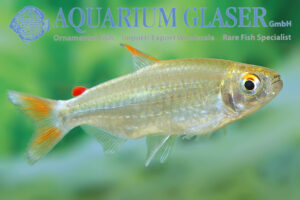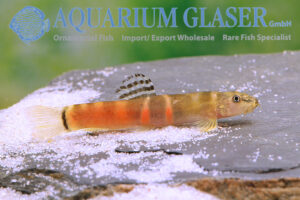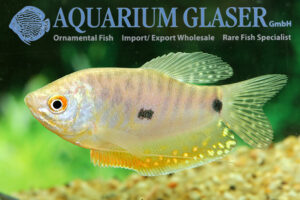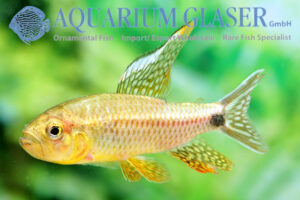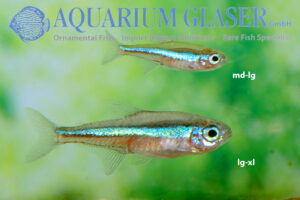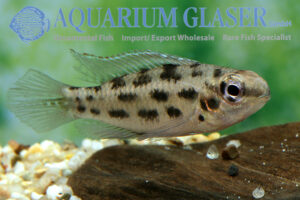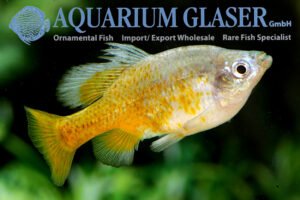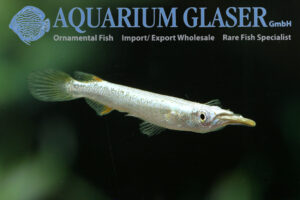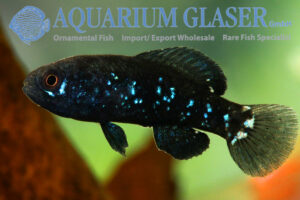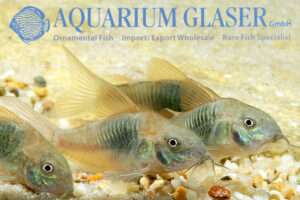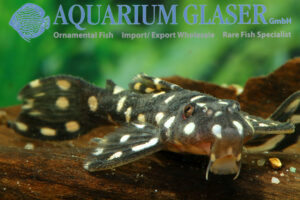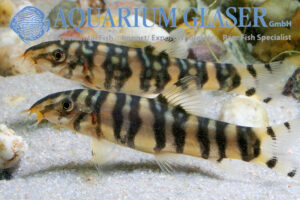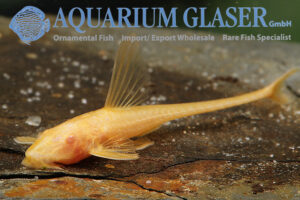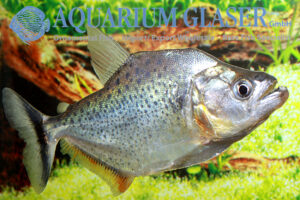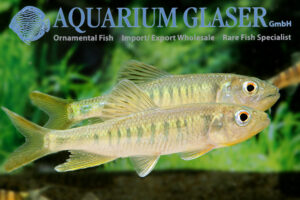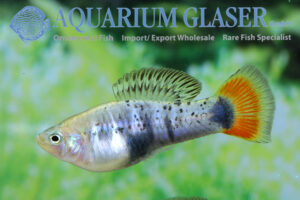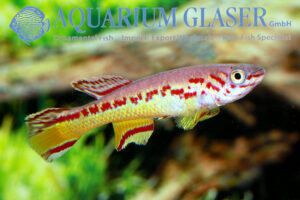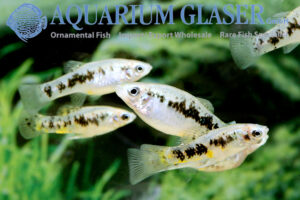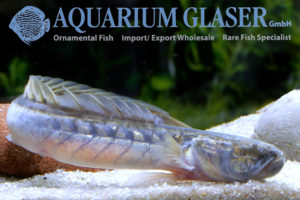Danio choprae, also known as the ruby or glow-light danio, comes to us from rivers and streams in Myanmar. At a length of 4 cm, they are already fully grown. As with many schooling fish, the effect on the observer increases with the size of the school. A group of 30 animals roaming lively through […]
Fish Archive (3089)
-
-
Tenellus leporhinus
The thorny catfishes of the genera Doras, Hassar, Hemidoras, Leptodoras, Nemadoras and Tenellus look quite similar at the first glimpse and have often been confused with each other in the past, both in scientific and aquarium literature; accordingly, there are always small question marks behind the identification of rarely imported species. From Colombia we have […]
-
Carassius auratus Goldfish Comet red
Spring is approaching and with it the garden pond season. The simple goldfish breeding forms are best suited to this for a number of reasons, while high breeders (Oranda and Co.) have special requirements. But even with the “simple” forms – i.e. normal goldfish, comets, shubunkin and wakin – it is important to note that […]
-
Devario maetaengensis ( = Danio m., = Inlecypris m.)
The Danios are a very species-rich group of small to medium-sized carp fish, usually less than 10 cm in length. Most species have bright, iridescent colors and are excellent aquarium fish, some of which are standard in the global ornamental fish trade. The variety of forms makes it extremely difficult to get a complete overview […]
-
Hemigrammus rubrostriatus
In the past, we were only able to present this beautiful tetra, which was only scientifically described in 2015, as a rare by-catch (e.g. https://www.aquariumglaser.de/en/09-characoids-tetra-relationship/hemigrammus-rubrostriatus/). However, we are now able to import these beautiful fish from Venezuela on a regular basis, as we have done again recently. The approximately 4-5 cm long animals are fully […]
-
Pterophyllum “Platinum”
White animals exert a special attraction on many people. In myths and fairy tales, it is often white individuals of a wild animal species that have magical properties. This explains why white rabbits, white pigeons, white mice etc. also have a special status among pets, and ornamental fish are no exception. The loss of color […]
-
Luciosoma setigerum
The barb Luciosoma setigerum with the extremely aerodynamic shape originates from Indonesia. Despite the size the fish can reach – up to 25 cm – the peaceful and splendid colored fish is an ideal inhabitant for a community tank with other large barbs from Asia, like Bala sharks (Balantiocheilus) or Sahyadria denisonii. For our customers: […]
-
Freshwater rabbitfish
The rabbitfishes of the genus Siganus are well known to marine aquarists. They are beautiful animals that usually grow to 15-30 cm in length and eat mainly vegetable food. Until now no freshwater species of the genus was known, only Siganus vermicularis is regularly found as juvenile in the brackish water of river mouths. Now, […]
-
Veiltails – as colorful as Easter eggs
Easter is just around the corner, it’s getting warmer. Goethe has his Dr. Faust say on his Easter walk: “From the ice they are freed, the stream and brook, By the Spring’s enlivening, lovely look;” (translation by Edgar Alfred Bowring, 1853) and this also applies to garden ponds. For many, garden pond time is also […]
-
Mastacembelus unicolor
Some time ago we were able to introduce you to the large, magnificent Mastacembelus unicolor, which was sent to us by mistake as M. erythrotaenia (see https://www.aquariumglaser.de/en/22-spiny-eels/mastacembelus-unicolor-2/). The animals at that time were too large for the photo aquarium, so we were only able to take photos from the regular sales tank. Now we have […]
-
Hemigrammus hyanuary Wild
In 1957, when the first Green Tetras or Neon Costello (Hemigrammus hyanuary) were imported, the tetras were absolute fashion fish. Otherwise the comparison with the neon or cardinal tetra can hardly be explained, because H. hyanuary – which by the way is named after Lake Hyanuary in Brazil – is really nicely colored, but it […]
-
Andinoacara pulcher “Neon Blue”
Exactly 10 years ago, a new star appeared in the ornamental fish sky. A beautiful sky-blue (to stay in the picture) cichlid conquered the world. It was first offered to us in February 2014 under the name “Nannacara Neon Blue” from Singapore. However, it was clear from the outset that it was not a representative […]
-
Auchenipterichthys coracoideus (formerly: A. thoracatus)
A few decades ago, the Zamora catfish was the most commonly imported driftwood catfish. At that time it was identified as Auchenipterichthys thoracatus. It was not until 2005 that it was discovered that although the species A. thoracatus exists, it is not identical to the Zamora catfish. Its correct name is Auchenipterichthys coracoideus. While A. […]
-
Pseudosphromenus cupanus
What are the reasons for choosing this or that fish for your home aquarium? In the beginning, it’s probably basically the colors. Over time, you develop a feeling for the wealth of shapes in the realm of fish, then swimming behavior and body shape are added to the selection criteria. And finally, you delve deeper […]
-
Poecilia butleri
The species of the Poecilia sphenops complex – P. butleri, P. mexicana and P. sphenops – are among the most common, most widespread and most diverse livebearing toothcarps in Central America. The diversity of forms both geographically and within each population is enormous. There are almost always large and colorful so-called alpha males and (from […]
-
Pseudorinelepis sp. L95a
At present, only one species of Pseudorinelepis is recognized by scientists, namely P. genibarbis. According to this assumption, the species is widely distributed in tropical South America and occurs in the Amazon and its tributaries as well as in the Orinoco and its catchment system. According to this theory, the color differences observed in living […]
-
Ancistrus sp. LDA45 / L349
Hardly any other genus of loricariid catfish, often referred to as L-catfish, is as widespread and important in aquariums as Ancistrus. Practically every aquarium is home to a few of these problem-free animals, which do an excellent job of cleaning the glass, look bizarre and hardly disturb other fish. But when it comes to identification […]
-
Astronotus Red, Albino Red and Red Chili
Oscars (Astronotus) are naturally very variable in color. In addition to wild-colored animals, cultivated forms have also enjoyed great popularity for decades. Why is the Oscar called Oscar? To be honest, we don’t really know. But it is certain that the name originated in the USA. In 1936, an article by E. W. Clarke on […]
-
Pterophyllum “California”
The freshwater angelfish (Pterophyllum) is one of the most popular ornamental fish of all. The species name Pterophyllum scalare is usually chosen for the cultivated forms, although this does not describe the situation correctly from a scientific point of view. The cultivated forms, which were mainly created in the 1940s to 1960s, are partly based […]
-
Pterodoras granulosus
The Thorny Catfishes (Doradiae) are a small family of exclusively South American catfish. Currently 41 genera containing 127 species are known, but continuously new species become discovered. The largest species attain a maximum length of more than 100 cm. The world record for Opsodoras niger is 120 cm and a weight of 20 kg. The […]
-
Geophagus taeniopareius
In 1981, the first report appeared on a Geophagus species imported as by-catch, which the author, Rainer Stawikowski, initially referred to as the “Yellow Cheek-Stripe Eartheater“. The relatively slender species is very much out of the usual range of Geophagus, both physically and in terms of brood care behavior. Nevertheless, it took until 1992 for […]
-
Pethia conchonius (formerly Barbus or Puntius conchonius)
The rosy barb (Pethia conchonius) was first brought to Germany in 1903 and has since developed into a worldwide classic among ornamental fish. It is one of the 100 most commonly traded species. They are hardly ever wild-caught, although these fish are so common in their native country India that they are traded in large […]
-
Pterophyllum sp. “Rio Nanay” bred
Like so many cichlids, angelfish also develop different-looking forms within their large distribution area. Whether these forms are classified as independent species, as subspecies or as color variants is ultimately a matter of taste and a philosophical issue. There are also individual differences within each population; in the case of the angelfish of the Rio […]
-
Panaque from Colombia: L190, L191, L330
We can currently offer all three striped Panaque from Colombia, namely L330 Panaque nigrolineatus laurafabianae (Colombia: upper Rio Guaviare drainage), L190 Panaque nigrolineatus nigrolineatus (Colombia/Venezuela: Rio Meta and lower drainage of the Rio Guaviare) and L191 Panaque cf. titan (Colombia: Rio Caguán, drainage of the Rio Caqueta). We have comparable sizes of all three forms […]
-
Rohanella titteya (formerly Barbus or Puntius titteya)
The cherry barb has recently been assigned a new genus (see https://www.aquariumglaser.de/en/08-carp-like-fishes-2-barbs-minnows-carps-goldfish-etc/new-generic-names-for-former-puntius/). In the genus Rohanella – named in honor of Rohan Pethiyagoda, one of the most prominent ichthyologists of our time – there is only one species, R. titteya. DNA studies have shown that the different geographical locality variants are not genetically far enough […]
-
Batrochoglanis sp. I
From two different suppliers, one from Peru and one from Colombia, we have received a catfish of the genus Batrochoglanis, whose identification to species level is not possible according to the publications to date. Representatives of the genus Batrochoglanis are not difficult to recognize as such; typical of the genus is the shape of the […]
-
Macropodus spechti “Royal Blue”
We have again received a nice number of beautiful domestic offspring of this extraordinarily beautiful black paradise fish (Macropodus spechti “Royal Blue”). For the history of this variant see https://www.aquariumglaser.de/en/25-perchlike-fishes/macropodus-spechti-royal-blue-2/ In the meantime, the fish have been further developed in terms of breeding and are preferably bred with animals that – very similar to Belontia […]
-
Barbodes “schuberti”
Brocade is a very heavy, strong fabric. It used to be considered particularly noble and precious, as the base fabric was made of silk and gold and silver threads were woven into it. All in all, brocade was a fabric for ceremonial robes and similar purposes. The golden barb is called brocade barb in German […]
-
Jupiaba anteroides – follow-up
We recently introduced you to the Jupiaba anteroides from the Rio Cenepa in Peru, which we imported recognized for the first time (see: https://www.aquariumglaser.de/en/fisharchive/jupiaba-anteroides-2/) In the meantime, the few specimens still remaining with us have got into the mating mood and the males have taken on a quite astonishing mating coloration with a tomato-red belly. […]
-
Gymnotus javari
With currently 45 recognized species (as of January 2024), the genus Gymnotus is the most species-rich group of New World knifefish. Research into the species diversity of Gymnotus only began at the turn of the millennium; until then, only around 12 species were differentiated. From 2001 onwards, comprehensive papers with species descriptions and phylogenetic analyses […]
-
Rita rita
The Rita catfish, Rita rita, is one of the most sought-after food fish in the Ganges-Brahmaputra system in India, Pakistan and Bangladesh. Although the species has a large distribution area and is classified as “least concern” overall, certain local populations are apparently overfished. This species, which reaches a length of up to 150 cm, is […]
-
Discus Special (3): Brown/blue Discus
Small wild-caught fish Discus cichlids, like all cichlids, only develop their full coloration when they are largely mature (i.e. approx. 15 cm long in the case of discus). This is generally known and one of the reasons for the popularity of Asian color breeds, as they already show their full color at lengths of 7-9 […]
-
Discus Special (2): Discus Green 7-9 cm
Small wild-caught fish Discus cichlids, like all cichlids, only develop their full coloration when they are largely mature (i.e. approx. 15 cm long in the case of discus). This is generally known and one of the reasons for the popularity of Asian color breeds, as they already show their full color at lengths of 7-9 […]
-
Discus Special (1): Discus Heckel Rio Negro 7-9 cm
Small wild-caught fish Discus cichlids, like all cichlids, only develop their full coloration when they are largely mature (i.e. approx. 15 cm long in the case of discus). This is generally known and one of the reasons for the popularity of Asian color breeds, as they already show their full color at lengths of 7-9 […]
-
Platy Blue Butterfly Moon
The first glance into an aquarium with this breeding form of Xiphophorus maculatus may only reveal beautiful blue platies with a large tail root spot (“Moon” or “Mickey Mouse”). But a second look shows that there is more to these fish, especially the males! They are multi-colored. Dominant, optimally colored males of this breeding form […]
-
Thiara winteri
The pretty Thiara winteri from Indonesia with its pagoda-like shell, the longitudinal ribs of which are more or less (this varies greatly from individual to individual) spiky at the junctions of the coils, belongs to the group of trumpet snails relatives to which, for example, also belongs the very common red-rimmed melania (Melanoides tuberculata). The […]
-
Calophysus macropterus
The predatory catfish Calophysus macropterus belongs to the medium-sized species of the Pimelodidae (antenna catfish), the largest representatives of which can reach a length of around 2 meters. The largest Calophysus measured to date (there is only one accepted species, C. macropterus) is said to have been approx. 60 cm long, but animals as long […]
-
Rineloricaria sp. Jacareacanga
We have received a small number of these new, really unusually marked Rineloricaria sp. Jacareacanga – named after the place where they were found on the Rio Tapajós. Many thanks to Ingo Seidel for the information on the origin of these catfish! Our largest animals are about 15 cm long. They are real beauties, who […]
-
The scientific species name of discus cichlids: an open question
The question of which scientific species names should be given to the various discus cichlids is a controversial one. There is agreement that all Symphysodon populations are relatively closely related to each other and that preserved specimens cannot be identified with certainty without color and location; the only exception is the Heckel discus (Symphysodon discus), […]
-
Jupiaba anteroides
For a variety of reasons, aquariums were predominantly small until the 1960s and held 10-100 liters of water. Accordingly, aquarists focused on small fish. It was only when the cichlids of Lake Malawi were imported that the trend changed. These “coral fish of freshwater” need large tanks due to their high intraspecific aggressiveness and soon […]
-
Poecilia “Chocolate”
Perhaps the most unusual of all Molly breeding forms is Chocolate. This is because it is a dark-colored albino! At first, this sounds like an absolute contradiction in terms, like a “round corner” or the “black mold”. But it’s still true. In the chocolate molly, the red eyes of the albino meet a chocolate-colored body. […]
-
Temporarily closed
Dear fish friends, we are currently rebuilding something and therefore there will be no newsletters for a short time. We will hurry, we promise! Best regards The Aquarium Glaser team
-
Apistogramma sp. Nanay
The species characteristics of this dwarf cichlid from Peru are: distinct underbelly stripes, an orange “axillary spot” (the attachment point of the pectoral fin is intensely orange in color), a more or less distinct orange zone on the belly and a tail fin that is tipped at the top and bottom in old, fully developed […]
-
Guppy Multicolor
Who can keep track of the many, many breeding forms of livebearing toothcarps? Aquarists interested in guppy genetics know that there are thousands of possible color and fin combinations in these animals. Many of these (by no means all) can be bred in pure lines, given the appropriate ambition and perseverance. Can you blame the […]
-
Planiloricaria cryptodon
Currently we have wonderful flounder whiptail catfish from Peru in stock. They are currently 10-13 cm long. These sizes give only the body length, as in Planiloricaria there is a filament on the upper lobe of the caudal fin that is as long as the body! Maximum length given in literature is 35 cm. Nevertheless, […]
-
Aplocheilus armatus
New times bring new methods, new methods bring new findings. Who knows, perhaps Jack the Ripper would have been caught if the criminal techniques of fingerprint and DNA analysis had been available in 1888 when he committed his murders. Even before Jack the Ripper’s time, the many, many local forms of the common panchax (Aplocheilus […]
-
Mugilogobius myxodermus
Small freshwater gobies have recently attracted the attention of more and more scientists and, as a result, new species are constantly being discovered and old, almost forgotten species rediscovered. The genus Mugilogobius currently comprises around 30 species. It is not possible to be more precise because individual species are placed in different genera by different […]
-
Nannostomus sp. Cenepa Super Red
Recently we could present you a magnificent, deep red new pencil fish (see https://www.aquariumglaser.de/en/fish-archives/nannostomus-sp-super-red-2/). Thereby we mentioned a second species, the “Cenepa Super Red”, which we unfortunately only knew from internet pictures at that time. We now manage to import these magnificent animals on a regular basis. The “Cenepa Super Red” differs from the “Super […]
-
Channa pulchra
Sometimes supposedly small details are decisive, for example when it comes to species differences. There are two species of snakehead (Channa) that occur geographically close to each other in Burma (Rakhine State): Channa pulchra and Channa ornatipinnis. Both look quite similar and grow to a similar size (20-25 cm), but they differ considerably in their […]
-
Rasbora borapetensis
The blackline rasbora is a well-known aquarium fish that has been delighting ornamental fish enthusiasts since 1954. This completely peaceful schooling fish is ideal for enlivening the middle and upper water layers. Rasbora borapetensis, whose species name was chosen after the place where it was first found (the 220 km2 Bung Borapet swamp in Thailand), […]
-
Pseudetroplus maculatus (formerly: Etroplus maculatus)
The orange chromide, Pseudetroplus maculatus, is a well-known aquarium fish and has not disappeared from the tanks of enthusiasts since it was first introduced. Recent studies indicate that the three species of cichlids from India (Pseudetroplus and Etroplus) are not so closely related to the cichlids (Cichlidae), but rather to the damselfishes (Pomacentridae). However, this […]
-
Cleithracara maronii KOUROU
The Keyhole cichlid (Cleithracara maronii, formerly Aequidens maronii) is a well-known aquarium fish that has only rarely been imported to Europe as a wild catch since its first import in 1936. The demand is covered by captive breeding. Although the species has no striking colors – the very varied pattern consists of brown, grey, beige […]
-
Vittina turrita and V. semiconica
The nerites (Neritidae), also known as racing snails, are very popular. Their beautiful coloration is one of the reasons for this, but also their excellent properties as algae cleaners, which (if you keep enough specimens) reliably keep the aquarium glass clean. Plants, on the other hand, are left completely alone. And there is no unwanted […]
-
Misgurnus anguillicaudatus GOLD
The albino breeding form of a weather loach (Misgurnus) originating from subtropical Asia is currently enjoying a constant increase in popularity. We call it Misgurnus anguillicaudatus, but this is only a makeshift name, as the correct species names of the Asian Misgurnus species cannot currently be determined. The albino weather loach reaches a length of […]
-
Manarma moeschii ( = Pseudosesarma moeschii)
The red mangrove crab or red Thai crab is by far the most popular crab for paludaria (combined aquaria and terraria). What is not yet widely known is that it was placed in a different genus – Manarma – in 2020. In the hobby, the species name is also traditionally misspelled. The correct name is […]
-
Rhinogobius zhoui
This freshwater goby, which attains a maximum length of 4-5 cm, is one of the most attractive discoveries of ornamental fish of the last years. However, in the beginning the fish were extremely expensive. Currently we can offer them for a comparably moderate price. Rhinogobius zhoui originates from China. In the natural habitat – brooks […]
-
Batasio fasciolatus
For the first time ever we obtained a species of Batasio from North Bengal in India. They belong to the species Batasio fasciolatus, which was described scientifically only in 2006. One can see that the determination of species of Batasio is not that easy keeping in mind that B. fasciolatus was already subject of an […]
-
Caridina multidentata Orange and Snow
The Amano shrimp, Caridina multidentata (formerly: C. japonica) is the most popular of all aquarium shrimps. However, it is only available seasonally from wild collections. However, as there is a year-round demand, the species is bred on a large scale. For German offspring, see here: https://www.aquariumglaser.de/en/31-crayfishes-shrimps-crabs-snails-mussels/amano-shrimp-now-also-available-as-german-offspring/ When animals are bred, sooner or later color or […]
-
Leptobotia tchangi
The loaches of the genus Leptobotia differ from all other botiide loaches in that the razor-sharp, sickle-shaped spine under the eye, which all botiide loaches can erect and lock in the event of a perceived or real threat, is only single-pointed. In Botia & Co. it is usually two-pointed. At present, around 20 species are […]
-
Dalmatian, Marble and Calico mollies
At least three species of mollies are the source species of the numerous breeding forms of these fish that exist today: Poecilia sphenops, P. latipinna and P. velifera. P. mexicana may also have been involved, but this is unclear as this species was long regarded as a synonym of P. sphenops. The scientific differentiation of […]
-
Sarcocheilichthys parvus
The genus Sarcocheilichthys from China has the potential to become a new star in the ornamental fish sky. There is a complex of small (6-7 cm) species within the genus in southern China, which are characterized by a broad longitudinal band. The males of all three species develop very pretty vermilion fins at spawning time. […]
-
Corydoras seussi
In the huge variety of species of Corydoras, four species stand out in particular due to their bright orange pectoral and dorsal fin spines: Corydoras sterbai, the associated long-snouted C. haraldschultzi, C. gossei and its long-snouted counterpart C. seussi. We aquarists are naturally delighted by this sight, but we should not forget that these are […]
-
Pseudancistrus genisetiger
This beautiful loricariid catfish was already scientifically described in 1941. The type locality is the drainage of the Rio Jaguaribe in the Brazilian state of Ceará in the north-east of the country. The maximum length published to date is around 13 cm (10 cm without caudal fin). The Rio Jaguaribe is notorious for its erratic […]
-
Marosatherina ladigesi
The Celebes Rainbow, Marosatherina ladigesi, is perhaps still remembered by some readers as Telmatherina ladigesi. The species lives endemically (i.e. – seen worldwide – exclusively there) in cool karst streams in the area around Bantimurung, Maros karst, Sulawesi Selatan; Sulawesi belongs politically to Indonesia, but zoogeographically to the Australian region. In former times the big […]
-
Parambassis siamensis
Formerly this species of glass perch was the most common found in the trade. It has a very wide distribution through Thailand, Vietnam, Cambodia, and Laos. However, Parambassis siamensis was most often mis-identified and traded under the name “Chanda wolffii”. P. siamensis is very similar to the Indian species P. ranga. Both are distinguished by […]
-
Rubricatochromis sp. Neon
If aquaristics were exclusively about colors, there would hardly be any need for species other than Rubricatochromis. The “Neon” is probably a breeding form created by crossing and selection, in which the blue iridescent spots, which most red jewel cichlids have, are combined to form larger areas. In terms of body shape, Hemichromis sp. Neon […]
-
Boesemania microlepis
The drums (Sciaenidae), to which Boesemania microlepis belongs, are mainly known from the sea. Only a few of the approximately 300 species live permanently or occasionally in freshwater. These fish are known as “drums” because they make a very audible sound. Larger schools of these fish have already triggered submarine alarms because they cast a […]
-
Spatuloricaria sp. „Black-White Peru“
The genus Spatuloricaria comprises currently 13 accepted species. Members of this genus are large, splendid whiptail cats. There is probably no species that stays smaller than 30 cm in length, some become definitely larger. This means that the fish have to be kept in large aquaria. Spatuloricaria are sensitive against poor water quality. Thus a […]
-
Rhinogobius shennongensis (2)
The brook gobies (Rhinogobius) are as adult fishes pure freshwater inhabitants, which are found at most once in the brackish water of the lower reaches of running waters; but even this is the exception, not the rule. With 140 described species, 72 of which are generally considered valid, there is still a wide open field […]
-
L90a Panaque bathyphilus
The large, wood-eating Panaque species have their loyal fans. Although these animals only reach us in relatively small numbers, they have been on offer from exporters for decades. This includes L90, the variably colored Panaque bathyphilus from Peru, which can easily reach a body length of 60 cm in old age. We have reported on […]
-
Corydoras sarareensis ( = C23)
It has been almost 20 years since we were able to offer this beautiful armored catfish from Brazil. Corydoras sarareensis, which was given its species name after the Rio Sarare from which it originates, was only scientifically described in 1995. Prior to this, the species was known as “C23” in the hobby. The Rio Sarare […]
-
Pseudocrenilabrus sp. Ruaha
The small mouthbrooders of the genus Pseudocrenilabrus have been kept and bred in the aquarium since the beginning of modern aquaristics – in the 1880s. The species P. multicolor was once so popular that it was simply called “the mouthbrooder“, although it was already known at the time that there were hundreds of species of […]
-
Beaufortia kweichowensis
The name for this hillstream loach may be new to you, but you know the animal. In fact, Beaufortia kweichowensis is or was the most common hillstream loach in the trade and was traded as “China Pleco”, “Chinese Butterfly Sucker” or “Butterfly loach”, with the scientific name usually being Beaufortia leveretti. Beaufortia leveretti really does […]
-
Brachyplatystoma tigrinum (formerly: Merodontotus tigrinus)
It’s hard to believe, but this striking and large catfish – the species reaches a final length of approx. 85 cm – which is also widely distributed in Amazonia (Ecuador, Peru, Colombia, Bolivia, Brazil) was only discovered in 1981! It was described in the genus Merodontotus, which was created especially for it, but is now […]
-
Periophthalmodon septemradiatus
Within the true mudskippers – these are the species that actively leave the water and search for food on land, etc. – there are two genera: Periophthalmus (19 species) and Periophthalmodon (3 species). They do not differ externally, only in the structure of their teeth. We have now received Periophthalmodon septemradiatus from India, a beautiful […]
-
Pseudorasbora elongata
The genus Pseudorasbora comprises only five accepted species. Representatives of the genus can be easily recognized by the upwardly directed mouth fissure, a characteristic that is rare within the carp fish (Cyprinidae). Pseudorasbora is originally distributed in East Asia (China, Russia, Japan). One species, P. parva, was unintentionally introduced in the 1970s with food fish […]
-
Cichla kelberi “Spider”
Just a few decades ago, the Peacock Basses from South America (genus: Cichla) were considered almost unsustainable for aquaria, but nowadays they are bred regularly and in large numbers. The latest craze is Cichla kelberi “Spider”, a breeding form whose origin is not yet known. The photos show our current stock, 16-18 cm long specimens, […]
-
Oryzias latipes “Medaka Black”
The small rice fish Oryzias latipes was domesticated by humans at an early stage and was one of the very first exotic fish species to arrive in Germany before the turn of the 19th and 20th centuries. It became the pet of geneticists, so to speak – especially in Japan – who conducted and still […]
-
Inpaichthys sp. “Red Eye”
It’s amazing how many new and extraordinarily beautiful tetra species have appeared in recent years. Among them is an Inpaichthys species that has not yet been scientifically recognized and is referred to as the “Red Eye” by those who catch it. The I. sp. “Red Eye” differs from the well-known king tetra (I. kerri) not […]
-
Corydoras sychri
The beautiful Corydoras sychri from Peru – it lives in the Rio Nanay – is unfortunately only occasionally available. We currently have very nice, large specimens in stock. There are some species that can be confused with C. sychri. The best known is C. atropersonatus, which also comes to us from the Rio Nanay. C. […]
-
Hyphessobrycon epicharis (2)
We recently succeeded in importing the species Hyphessobrycon epicharis, which had previously only been imported in very small numbers (see https://www.aquariumglaser.de/en/09-characoids-tetra-relationship/hyphessobrycon-epicharis-2/ and https://www.youtube.com/watch?v=RBofRyOLk3g). Now we have succeeded in importing once more that species that is unmistakable due to its distinctive shoulder spot. This time the animals are somewhat smaller (and therefore cheaper), but more colorful. […]
-
Micralestes humilis ( = “M. stormsi”)
Unfortunately, Micralestes humilis from Nigeria is only offered relatively rarely. This species, which belongs to the Congo tetras, is a wonderful contrasting fish for West African aquaria. The bright red adipose fin of this species is particularly striking. On the one hand, it serves to keep the shoal together, but is also confusing for predatory […]
-
Schistura atarensis ( = Schistura cf. balteata)
There are a large number – over 300, of which over 200 are considered valid species – of scientifically described Schistura species; only very few of these have found their way into aquaria to date. One of the most beautiful is the species previously known as Schistura cf. balteata from Thailand, which was recently (October […]
-
Trichogaster trichopterus ( = Trichopodus t.)
The spotted gourami is one of the most important ornamental fish of all and is one of the top 100 worldwide. The species is extremely widespread in Southeast Asia. Despite its relatively small size (usually 8-10, rarely up to 15 cm), this gourami is used as a food fish and can survive for a long […]
-
Crenuchus spilurus
Crenuchus spilurus is the only formally described species of the genus Crenuchus. There is, of course, at least one other species in Venezuela (see https://www.aquariumglaser.de/en/09-characoids-tetra-relationship/a_new_species_of_crenuchus__en/). C. spilurus was originally described from the Essequibo River in Guyana. We have now once again received extremely beautiful specimens from Manaus (Brazil). In contrast to almost all other tetras, […]
-
Paracheirodon simulans lg-xl
The internationally since always Green Neon, in German also occasionally Blue Neon (to avoid confusion with Hemigrammus hyanuary, which is also called Green Neon) called Neon tetra Paracheirodon simulans we have more or less always in our assortment, see https://www.aquariumglaser.de/en/09-characoids-tetra-relationship/paracheirodon-simulans-2/ Now we have received from our supplier in Colombia comparatively extremely large specimens, as we […]
-
Dicrossus warzeli Bred
The rarest of all checkerboard cichlids in the aquarium is Dicrossus warzeli, which was known as Dicrossus or Crenicara sp. Tapajós before its scientific description. In 1992 the very characteristically marked dwarf cichlid was discovered in an unnamed tributary (Igarapé) of the great Rio Tapajós in Brazil by the traveling aquarist Frank Warzel and brought […]
-
Skiffia francesae
Every year in autumn we receive the “harvest” of the season from our goodeid breeders. Because of the extraordinarily long and mild summer, this year it was the end of October. As is well known, it does these fish extremely good in permanent breeding if they are temporarily maintained and bred under outdoor conditions. However, […]
-
Dermogenys siamensis Silver-White (D. pusillus)
There is a silver-white breeding form of Dermogenys siamensis (in the hobby usually called D. pusillus or D. pusilla, but this is a different species, which is not kept in the aquarium), in which – similar to the gold tetras – shiny color pigment (guanine) is produced in excess in the skin cells. In nature […]
-
Elassoma evergladei
The Pygmy Sunfish, Elassoma evergladei, is a classic dwarf fish and has been maintained and bred for many generations of aquarists. The species is best housed in a small species aquarium that does not require heating. The cute fish, growing only 2-3 cm, are completely peaceful, however the males defend an individual area against conspecifics. […]
-
Corydoras sp. aff. aeneus “CW26”
The Bronze Corydoras, Corydoras aeneus, is – this may be surprising – very poorly researched. We know armored catfishes that roughly correspond in appearance to C. aeneus from practically all of South America, we also know the appearance of animals from Trinidad (the place from which C. aeneus was scientifically described). We know that Bronze […]
-
Scobinancistrus raonii L82 ( = “Scobinancistrus sp. Orange Spot”)
The beautiful L82 originates from the lower Rio Xingu in Brazil (around Altamira). The species is very variable in terms of spot size and shape. Wild-caught specimens also often have a yellowish-orange spot coloration or shiny green-blue spots (“Opal-Pleco”). A few days ago (on October 30, 2023), the species, which received its L-number back in […]
-
Botia rostrata
To say it right away: nobody knows exactly which species of loach is hidden behind the name Botia rostrata from a scientific point of view. But this is not the right place to discuss such things. Especially interested people are referred to the very detailed work of Steven Grant (2007). The loach we present here […]
-
Rineloricaria lanceolata “Albino“
Albinism, i.e. the complete or partial absence of black color pigments in the body cells, occurs widely as a mutation in the animal kingdom. While albinos rarely survive in the wild because of their striking light color, they are particularly popular in commonly bred animals. On many people albinos seem very attractive. The species Rineloricaria […]
-
Serrasalmus irritans
Serrasalmus irritans is a slender piranha, described by the first describer Peters in 1877 as follows: “The area above the lateral line spotted black-blue. The caudal fin with a broad black-blue band enclosing the middle of the base, the broad margin yellow-white; the anal fin reddish, black at the margin. A specimen, 17 centimeters long, […]
-
Opsariichthys cf. songmaensis
From Vietnam we were able to import dragonfishes, which we first – at a superficial view – thought to be Zacco platypus. Then we looked a little bit closer and there were differences. First of all Zacco platypus has clearly wider body bands. So we started to do some research and that’s when it got […]
-
Xiphophorus variatus Rio Coacuilco (2)
About half a year ago we introduced this new variety of the wild form of the variable platyfish (https://www.aquariumglaser.de/en/18-toothcarps-killis-and-livebearers/xiphophorus-variatus-rio-coacuilco-2/). Now we have received the next generation of offspring from our breeder. This time we were lucky and an alpha male already formed with us. The alpha male is the dominant male within the social structure […]
-
Fundulopanchax amieti
Once again we have received Amiet´s Lyretail. Fundulopanchax (formerly: Aphyosemion) amieti is a magnificent, easy to care for and peaceful killifish. Our animals are German offspring. Originally the species comes from tropical Africa, the southwest of Cameroon (Sanaga system). Killifishes are generally considered to be fish for specialists, which live only a short time and […]
-
Limia vittata
We receive a very charming lifebearer from a breeder from Thailand: Limia vittata. This species, which originally comes from Cuba, has been known aquaristically for a long time: the first import date is 1913. In the hobby, however, the animals are only sporadically available. That is hardly to be understood, because each animal has an […]
-
Gobioides broussonnetii
Only rarely we can offer the dragon fish, Gobioides broussonnetii, which actually is a species of goby. Now we received once again from Colombia this strange bottom dweller. The maximum length of the species is said to be about 40 cm. They are absolutely peaceful plankton eaters, which should be offered fine sandy substrate in […]
- « Previous Page
- 1
- 2
- 3
- 4
- 5
- 6
- …
- 31
- Next Page »





